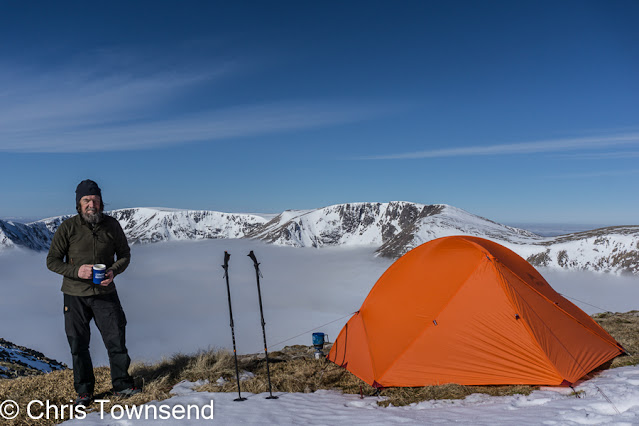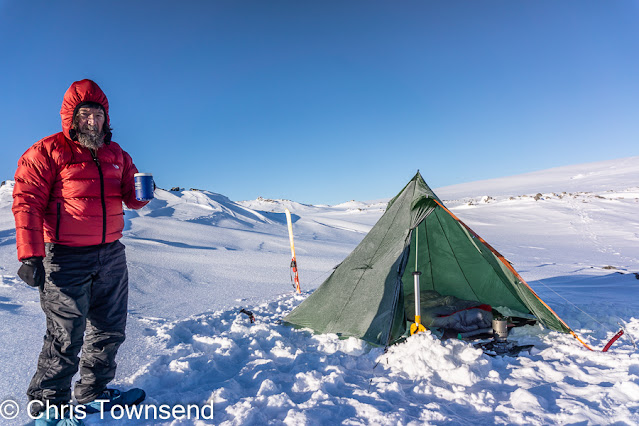This article is expanded from one that appeared earlier in the year as part of a series of articles on tents and backpacking I wrote for The Great Outdoors in conjunction with Hilleberg. I posted the first article on choosing a tent last month.
Shelters, whether tents or tarps, really come into their own when the weather turns stormy.
The way you pitch a shelter is often key to how secure it will feel. It can be immensely comforting to be warm and dry in the wilds inside a shelter you know is sturdy and well-pitched while rain, wind or snow whirl outside. Conversely, being inside a poorly pitched shelter which seems at risk of collapsing can be a very unnerving experience and guarantees a poor night’s sleep.
To maximise storm-worthiness there are a number of things
you can do. The first is to ensure you are familiar and well-practiced at
pitching your shelter so you do it quickly and efficiently in poor conditions –
a howling storm is not the best time to be fumbling with a confusing mass of
flapping nylon. Knowing the capabilities of your shelter is important too.
 |
| On a showery very windy day I found a sheltered site by dropping down into the top of a forest in the lee of the wind |
1. Pitch selection
In very windy weather, a sheltered site is
well worth taking the time to find, though sometimes an exposed pitch may be the
only option there is. Often, though, there are options; even a gentle bank or a
pile of rocks can help cut the wind. Passing by that lovely hillside pitch and
continuing downhill to a less windy spot is a good idea. In heavy rain, be wary
of damp hollows though; these could fill with water. In woods, look up. Camping
under a dead branch is a bad idea.
 |
| On a day of heavy rain and strong winds I descended into a glen to find a sheltered spot and then spent some time finding a slightly raised spot in case the river rose. |
2. Pitching
To stop your tent blowing away, peg down one end securely before inserting any poles or laying the tent out. In really strong winds you can put your pack on the tent while you do this or even lie on it. Then peg down the other end before inserting the poles (you may then have to unpeg each corner in turn to get the poles in).
Tunnel tents should be pitched with the rear into the wind for best stability. With other designs the door should be away from the wind if there’s only one.
3. Pegs and guylines
Pegs should go in at about a 45-degree angle (leaning away from the tent) right up to their heads. Carry a selection of different pegs for different ground conditions – thin ones for stony and hard ground, wide ones for soft ground – so you can do this. In hard ground pegs can be pushed in with your feet or hammered in with a small rock. Don’t hit them too hard, even the toughest pegs can bend or break (a good reason for carrying a few spares).
If pegs really won’t go fully into the
ground, pegging loops and guylines should be looped round the peg at ground
level – higher up and they could lever the peg out. All guylines should be
pegged out and tightened. I do this even if it’s calm – the wind may pick up
during the night.
Pitching in snow
It’s always preferable to pitch on dry ground rather than snow – it’s easier to do and the tent will be warmer, especially under you. When snow cover is extensive camping on it may be the only option. When this is the case a snow shovel is very useful for preparing the site (and transporting snow for melting for water). I always carry one.
In soft snow, a platform should be stamped out then levelled for the tent. The platform should be as flat as possible – any lumps will harden under you. Leading the platform to firm up is the best way to avoid this but in a storm you’ll want to get under cover as soon as possible.
Special extra wide and long pegs are useful for snow. In soft snow these should be buried horizontally with guylines looped round them. Extra cord may be needed for pegging points round the edge of the flysheet for this. Ordinary pegs can be buried like this too. Stamp down on the snow above the peg to harden it – they’ll freeze in place and you may need an ice axe to dig them out the next day. Ice axes, trekking poles, and skis can be used as pegs in snow too.
5. Securing gear
Before pitching the tent, ensure all other gear is in your pack and the lid is shut so it stays dry and doesn’t blow away. Tent stuffsacks should be pushed into garment or pack pockets to stop them being lost to the wind.
Final checks
Before getting inside the tent check all pegging points are secure and tighten the guylines. In rain it’s worth getting out last thing before sleep to tighten everything again – some tent fabrics stretch when wet. If it’s snowy, knock any snow off the tent. In very heavy snow you may need to do this during the night too.
7. Keeping the inner dry
Fill up water containers and do any other outside chores before entering the tent. If your outer clothing is wet, strip this off in the porch. A small sitmat is useful for kneeling on to do this. The idea is to keep any damp gear out of the inner tent so it stays as dry as possible.










Some top tips there Chris. Before I bought some snow stakes I successfully used supermarket carrier bags as anchors in deep snow. Filled with snow and then buried, the guy lines can be tied or looped around the handles. They may take a bit of digging out the next morning but they are cheap and very light to carry.
ReplyDeleteThanks Ian. I've done that with stuffsacks in deep snow. Works well but as you say digging them out can take time.
DeleteChris - thanks for these tips. I noticed the Sigma single skinned tent in the final pic. I have the same but was nervous whether it would be robust enough to handle winter conditions. Do you have any comments, or does it simply make pitching more critical if using say a lighter weight tent / tarp?
ReplyDeleteNigel, the Sigma has coped fine with some severe winter conditions. It's more stable than many tents.
DeleteThank you for the tips. Interestingly Hilleberg say to pitch the Nallo tent door into the wind.
ReplyDeleteThat puzzles me!
DeleteHere is their response: Hello,
DeleteGreat question! The best option is to pitch the vestibule end into the wind; this keeps the rear wall from pushing down on your feet and increases ventilation and strength.
Found it strange myself; I’ve sent you a photo (on Twitter and IG) showing their response to me.
DeleteI've never had a big problem with the rear wall pushind down on my feet. It does happen a bit but I'd rather that than have the porch thrashing about in the wind. I cook in the porch and like it to be as stable as possible. If Hilleberg finds pitching the front into the wind works then it obviously does. I'll go on pitching the rear of tunnel tents into the wind though. That works for me.
Delete